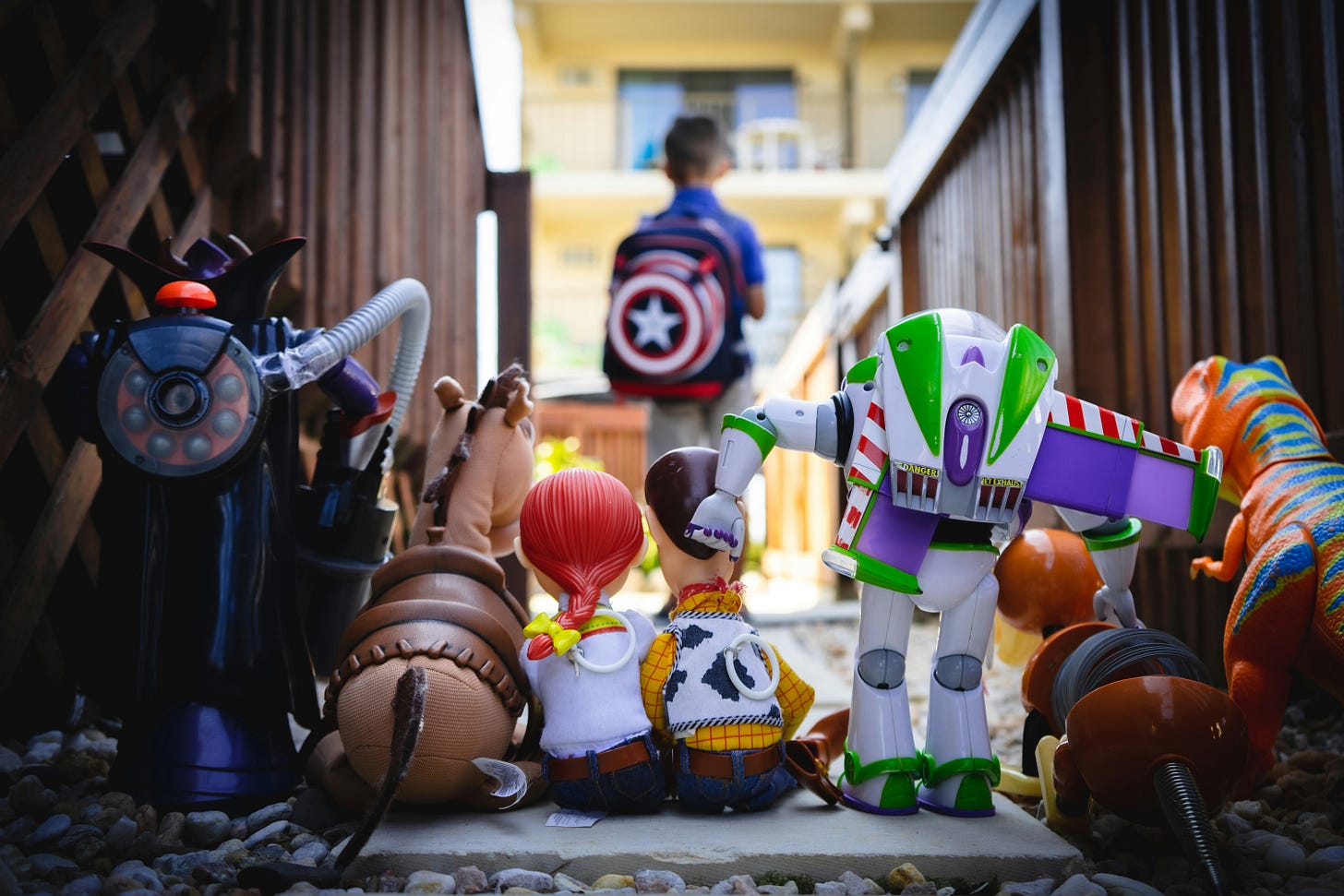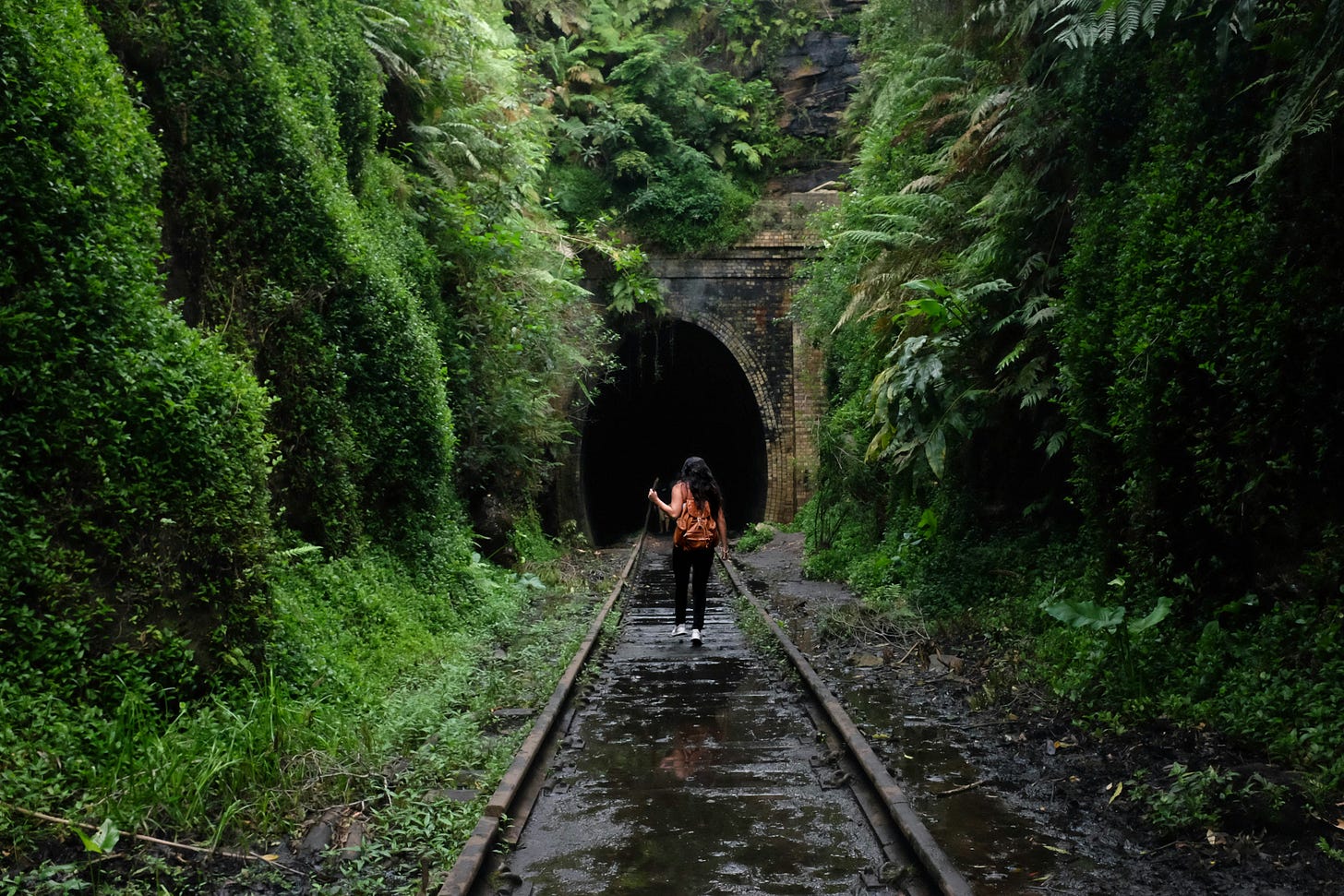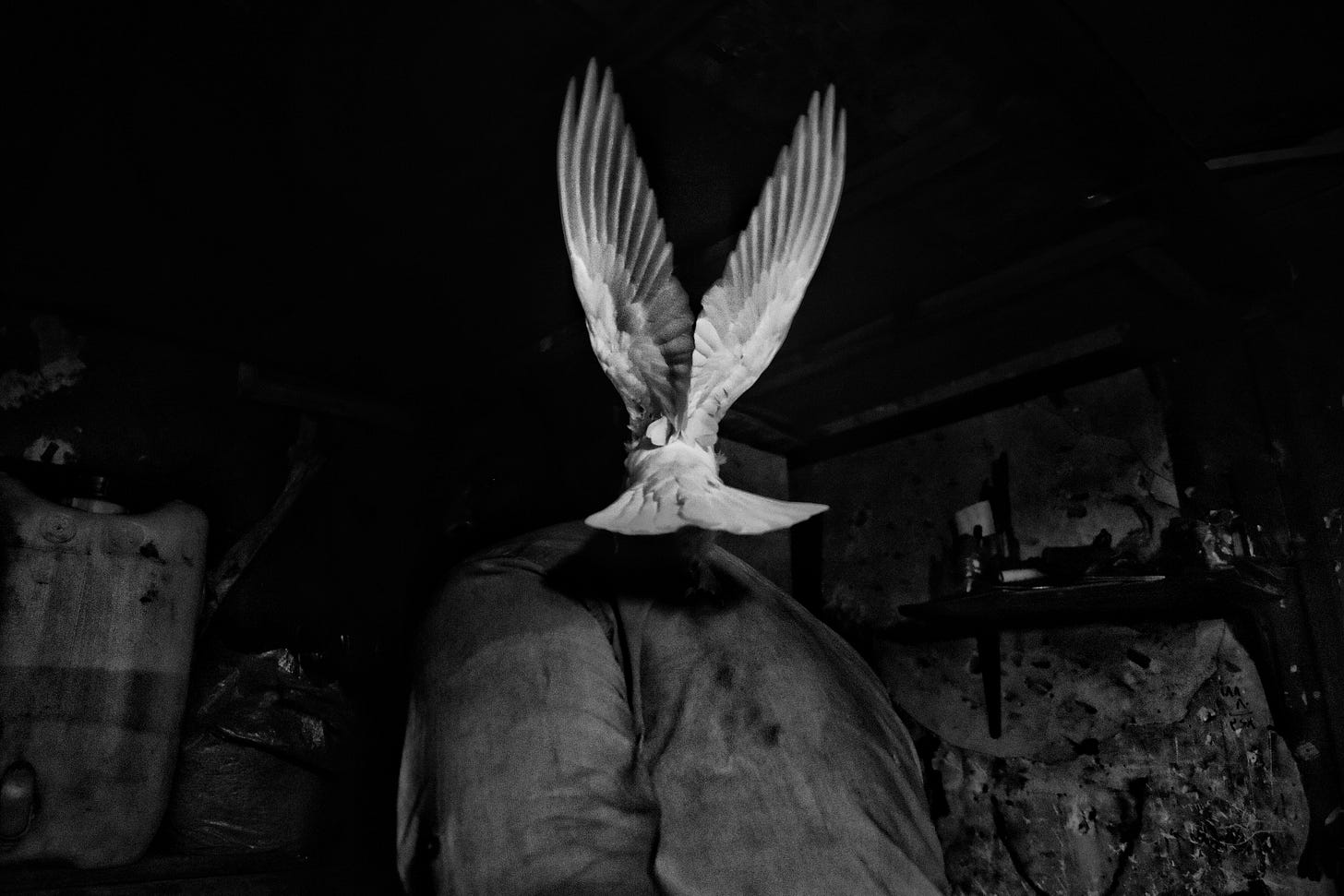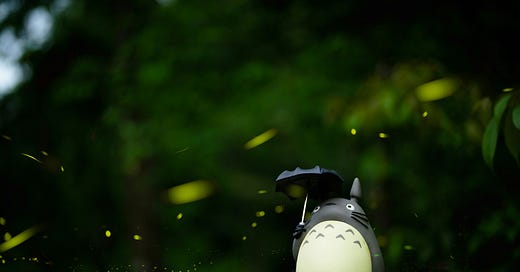Growing up as a child in Japan, I religiously watched and rewatched the holy trinity of animated films: Lion King, Toy Story, Tonari no Totoro (My Neighbour Totoro). I had Lion King on VHS, Toy Story on DVD and Totoro on a grainy VHS recording of a TV broadcast (replete with adverts). Kudos to Disney, Pixar and Ghibli for keeping me well entertained.

Now, if you’d asked me at the time if I believed they were real, I would have shook my head. There were obviously no talking animals in this world; that was an observable fact. Toys didn’t come alive; they were but inanimate objects. Totoro didn’t dwell in a large camphor tree in the neighbouring hills; though to be fair no one had ever spotted Totoro or his mini versions before, so I guess no one could exactly prove they weren’t real…
Did I believe that Totoro existed? No, not really. But I also didn’t not believe. (Unlike the way that I never believed that Santa Claus was real.) Perhaps in contrast with Disney and Pixar, there was something about Ghibli’s realistic and respectful depictions of nature that made it more believable, more near and present. And whenever I saw trees in real life, I couldn’t help but wonder.
Totoro lives in the hearts of all children throughout Japan, and when they see trees now, they sense Totoro hidden in them.1
When I first learnt about Paul Hiebert’s ‘excluded middle’, it was not so much discovering something new than having confirmed what I subconsciously knew all along.
Hiebert was an American missiologist who wrote a famous article in 1982 called ‘The Flaw of the Excluded Middle’ in which he explored why western missionaries were perplexed by spiritual phenomena in non-western cultures – namely because the western worldview excludes what he terms the ‘middle level’. The 17th/18th c. Enlightenment caused a two-tiered split between:
the high level (unseen things of the other world)
the low level (seen things of this world)
As a result, it eliminated belief in:
the middle level (unseen things of this world)
– or the overlap of the high and low levels, where supernatural powers and spirits impact the natural world.
[On] this level are beings and forces that cannot be directly perceived but are thought to exist on this earth. These include spirits, ghosts, ancestors, demons, and earthly gods and goddesses who live in trees, rivers, hills and villages. These live not in some other world or time, but are inhabitants with humans and animals of this world and time. In medieval Europe these included trolls, pixies, gnomes, brownies and fairies who were believed to be real. This level also includes supernatural forces such as mana, planetary influences, evil eyes, and the powers of magic, sorcery and witchcraft.2
(Totoro would belong on this list!)
Much of the West had/has excluded the middle level, relegating it as mere superstition. Whereas in contrast, belief in the middle level still persists strongly to this day, particularly in the Majority World.

I always knew there was more to life than what was visible to the naked eye – due to childhood inklings and spiritual experiences – and learning subsequently about the Holy Spirit and the biblical realm of spirits (e.g. angels and demons) only confirmed my suspicions.3 I’ve experienced terrifying demonic oppression – both in my dreams and whilst being fully awake; both directly as well as via objects. I’ve experienced comforting and awe-inspiring physical sensations (e.g. chills, pulsations) in my body caused by the Holy Spirit. Hiebert’s explanation made so much sense to me; the spirit world indeed impinged upon the material world. It reassured me that I wasn’t an anomaly even when I found myself in western environments which made me feel that I was.
I’ve met many in the West who try to discount spiritual experiences – i.e. excluding the middle level, whether intentionally or not – mostly because they don’t believe and/or understand and/or know how to deal with it.4 I know church leaders who won’t explicitly pray about/against the demonic. I know Christians who don’t believe in angels or demons since ‘spirits aren’t real’ – which makes me wonder if they even believe in the Holy Spirit. Greater awareness and acceptance of the middle level is a necessary corrective to this blind spot in the western worldview which has also thoroughly seeped into the western church.
Belief in the spirit world is intrinsic to an East Asian worldview and spirituality. Growing up in Japan, people would visit temples to pray whenever they needed divine provision or protection (e.g. exams, safe birth); or people would talk about having 霊感 (‘reikan’) or ‘spirit sensitivity’ (similar to the gift of discerning of spirits). In the words of Miyazaki Hayao describing an animism rooted in Japanese culture: ‘if you go back far enough in human civilization, I think all peoples probably felt that spirits dwelled in the sky, the clouds, the earth, and the stars – even in rocks, grasses, and trees.’5 As Simon Chan says, ‘In Asia the world of spirits is very much a part of everyday life.’6
This worldview is not so dissimilar from a biblical worldview and spirituality – aka ‘biblical realism’ as termed by Esther E. Acolatse – as demonstrated by the Bible’s cosmology and language of ‘many spirits’ (e.g. seven spirits in Revelation, spirits in prophetic visions, powers and principalities). I believe that East Asian theologies, which accept the existence and activity of the spirit world as fact, can help teach the western church. I wrote my dissertation precisely about this after being troubled by various incidents where Christians, well-intentioned as they were, dealt with spiritual experiences – middle level incidents – in a problematic and unpastoral way (e.g. gaslighting). I wanted to help the western church understand what it was missing, and to learn.

I’m glad I grew up within this worldview that transcends the limits of materialism, and aligns more accurately with biblical realism. Gene L. Green says about Asian theologies: ‘the Holy Spirit is not separated from the material world as is common in Western theology but is the primary essence of reality. Instead of opposing dichotomies, the Spirit is not outside the world but is “the complementary pair of yin and yang” that organizes all things.’7 An East Asian spiritual openness can potentially help shift the western church’s perspective from being purely materialistic to viewing the material in tandem with the spiritual – no longer making it an excluded but, what I term, an included middle.
More and more people – whether Christian or not – are increasingly having spiritual experiences in the West. Take this incident involving a ghost:
A student shared a word of knowledge with a man on the streets that led to his conversion. That word of knowledge was the name of the ghost that had been plaguing the man’s dreams, causing the man to become fearful and exclaim, ‘How did you know that name?’ However, in a subsequent prayer meeting, the testimony was relayed without mentioning the supernatural element of the word of knowledge (i.e. the ghost’s name) whatsoever.
I don’t know the ins and outs of what exactly happened since the spirit world is full of mystery; but as someone who does believe in the spirit world, it was much easier for me not to react to this incident with scepticism, but to treat it as reality. (I fear to think what would – or wouldn’t – have happened if the student had dismissed it as superstition.) And ultimately it brought this man much-needed deliverance from the bondage of fear – it was true for him – and that’s something to celebrate.
Recently I’ve been rewatching all the Ghibli films. And only recently did I realise that being raised on a diet of Ghibli films probably helped to inculcate an awareness and acceptance of the middle level as perfectly normal. Not all Ghibli films, of course; some are more overtly fantastical than others. But films like Totoro or Pom Poko, set entirely in the natural world but having the spirit world impinge upon it, were the most realistic. We all know that what you imbibe as a kid hugely informs your worldview. If an adult who didn’t believe in the middle level watched Ghibli films, I suspect they would relegate most of it as pure fantasy and fairy tale rather than believe any of it as ‘real’.
I’m definitely not advocating mindless acceptance of the animistic worldview. There’s a lot that doesn’t align with a Christian worldview, so there’s a real need to be discerning. A Japanese pastor once told me that if he wasn’t a Christian, he’d very likely believe in the spiritual worldview (e.g. animism, reincarnation) appealingly presented by the films of Shinkai Makoto (Your Name, Weathering With You, Suzume).8 In any case, we should avoid the other extreme: not just the flaw of the excluded middle, but also the expanded middle, where obsession and fear of the spirit world consumes our lives (predominantly in the Majority World).9 That can be just as unhealthy and dangerous.
But it’s also not right to throw it out completely and say there’s no such thing as spirits. Angels and demons exist; spirits exist. And even if Totoro doesn’t actually exist, perhaps the ‘existence’ of Totoro might help one believe in the spirit world just that little bit more.
Jessica Niebel, Hayao Miyazaki (Los Angeles: Academy Museum of Motion Pictures; New York: DelMonico Books, 2021), p. 151.
Paul G. Hiebert, ‘The Flaw of the Excluded Middle’, Missiology: An International Review, 10 (1981), 35–47, at p. 41.
Interestingly, I always did instinctively believe in demons as a kid – not so much angels – perhaps because evil is more visible in the world. Once I did learn about the Holy Spirit, it was easy to believe because I already (subconsciously) believed in the spirit world.
Obviously, there are many pentecostal/charismatic Christians in the West who absolutely do believe in the middle level/spirit world.
Niebel, Hayao Miyazaki, p. 148.
Simon Chan, Grassroots Asian Theology: Thinking the Faith from the Ground Up (Downers Grove: InterVarsity Press, 2014), p. 156.
Gene L. Green, ‘The Spirit Over the Earth: Pneumatology in the Majority World’, The Spirit over the Earth: Pneumatology in the Majority World, ed. by Gene L. Green, Stephen T. Pardue, and K. K. Yeo (Carlisle: Langham Global Library, 2016), pp. 1–12, at p. 5.
One might almost believe that you do need to sacrifice a tenki no miko (‘weather maiden’) to make sure you get good weather.
A. Scott Moreau, ‘Flaw of the Excluded Middle’, Evangelical Dictionary of World Missions (Grand Rapids: Baker Books, 2000), p. 363.




